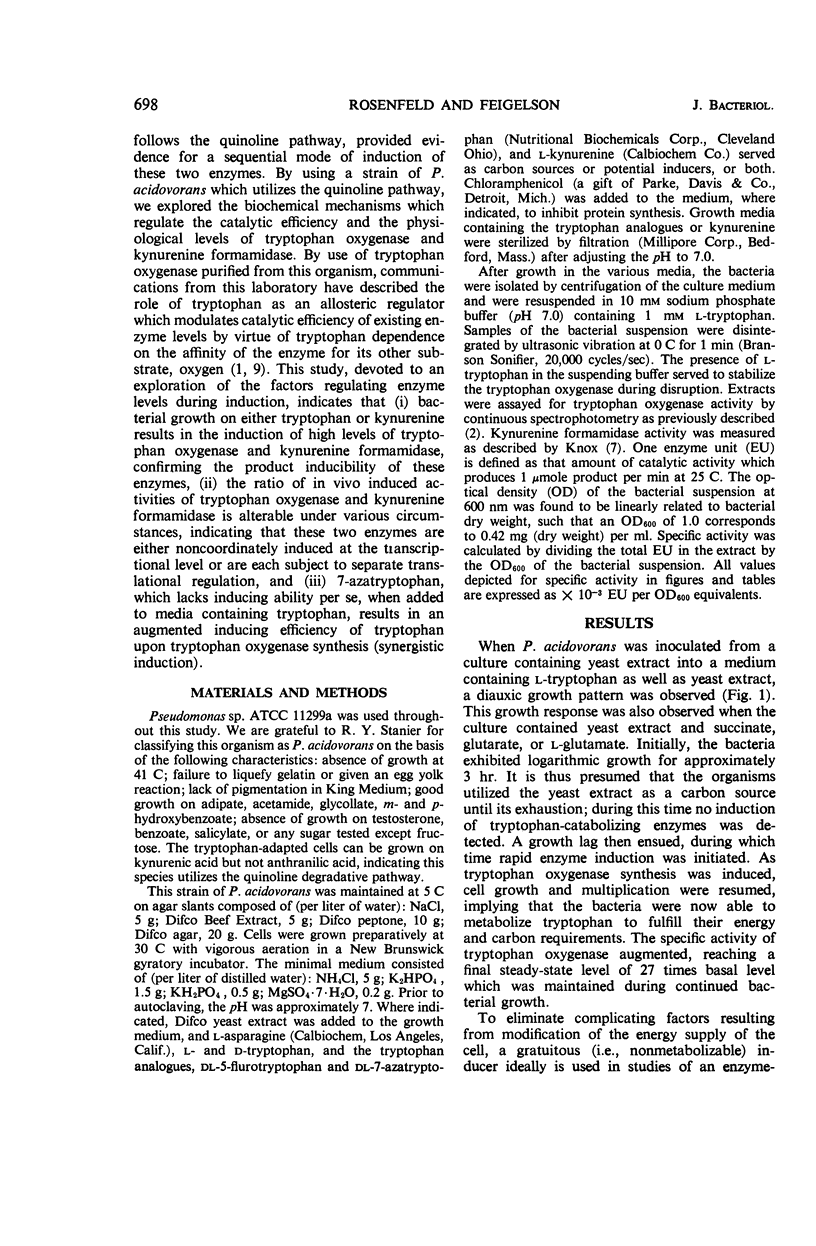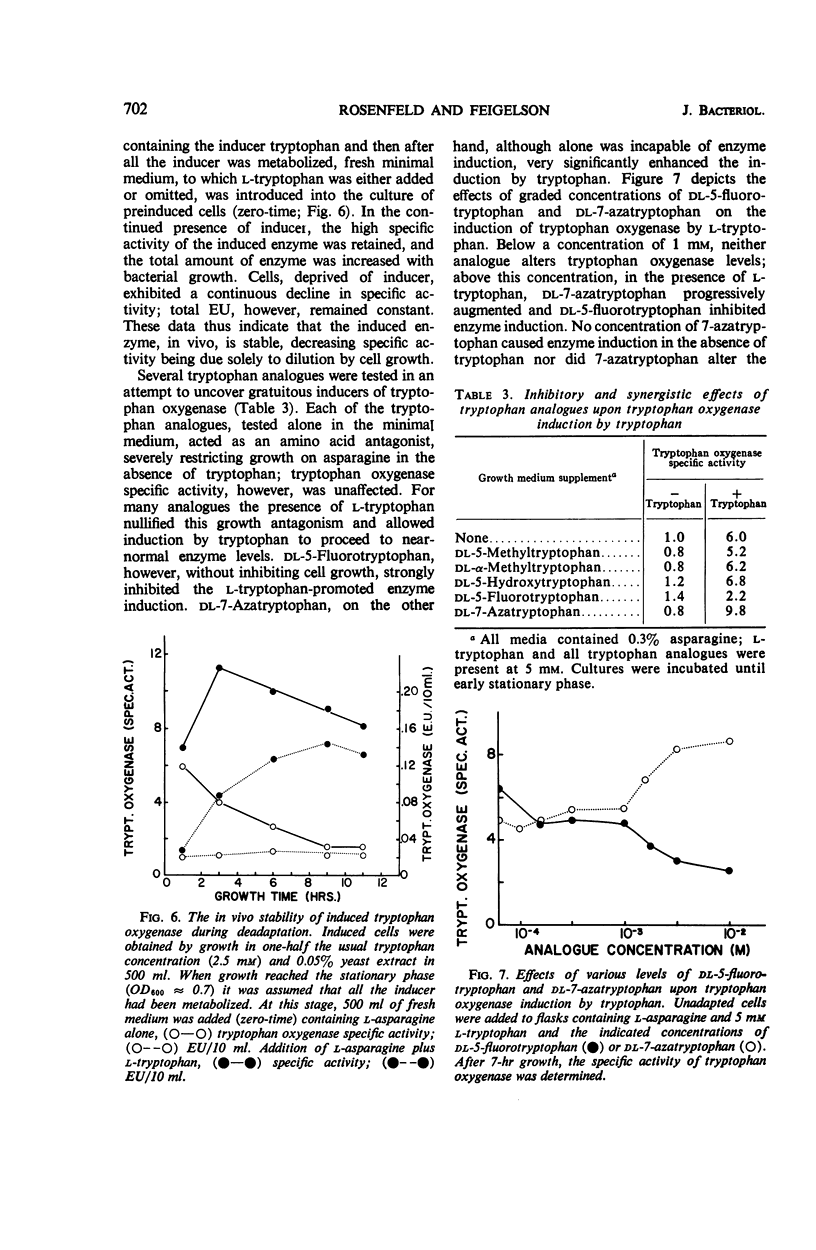Abstract
The process of induction of tryptophan oxygenase in Pseudomonas acidovorans is typical of many microbial enzyme induction systems, in that it (i) requires cell multiplication and de novo protein synthesis, (ii) is subject to catabolite repression, (iii) results in the formation of a stable enzyme, whose level, upon removal of inducer, is diluted out by cell proliferation, and (iv) exhibits product induction. l-Kynurenine was more effective than l-tryptophan as an inducer of both tryptophan oxygenase and the second enzyme of the pathway, kynurenine formamidase. The occurrence of product induction of these two enzymes by their common metabolite eliminated the possibility of sequential induction of these enzymes. dl-5-Fluorotryptophan, nonmetabolizable and devoid of any inducing activity, resulted in a concentration-dependent inhibition of the l-tryptophan-mediated induction of tryptophan oxygenase; kynurenine formamidase induction, however, was not influenced by the presence of dl-5-fluorotryptophan. dl-7-Azatryptophan, also nonmetabolizable and completely inactive as an inducer, acted synergistically with l-tryptophan and superinduced tryptophan oxygenase levels. When induction was conducted in a medium containing only l-tryptophan and 7-azatryptophan as inducing agents, then tryptophan oxygenase induction was enhanced, whereas the kynurenine formamidase level was essentially unchanged. These data indicate that various inducing conditions affect the relative proportions of tryptophan oxygenase and kynurenine formamidase, and thus indicate noncoordinate regulation of these enzyme activities.
Full text
PDF







Selected References
These references are in PubMed. This may not be the complete list of references from this article.
- Feigelson P., Maeno H. Studies on enzyme-substrate interactions in the regulation of tryptophan oxygenase activity. Biochem Biophys Res Commun. 1967 Jul 21;28(2):289–293. doi: 10.1016/0006-291x(67)90443-3. [DOI] [PubMed] [Google Scholar]
- GREENGARD O., FEIGELSONP The purification and properties of liver tryptophan pyrrolase. J Biol Chem. 1962 Jun;237:1903–1907. [PubMed] [Google Scholar]
- HUGHES D. E. THE METABOLISM OF HALOGEN-SUBSTITUTED BENZOIC ACIDS BY PSEUDOMONAS FLUORESCENS. Biochem J. 1965 Jul;96:181–188. doi: 10.1042/bj0960181. [DOI] [PMC free article] [PubMed] [Google Scholar]
- Hayashi S. I., Lin E. C. Product induction of glycerol kinase in Escherichia coli. J Mol Biol. 1965 Dec;14(2):515–521. doi: 10.1016/s0022-2836(65)80200-5. [DOI] [PubMed] [Google Scholar]
- Jacoby G. A. The induction and repression of amino acid oxidation in Pseudomonas fluorescens. Biochem J. 1964 Jul;92(1):1–8. doi: 10.1042/bj0920001. [DOI] [PMC free article] [PubMed] [Google Scholar]
- Jayaraman K., Müller-Hill B., Rickenberg H. V. Inhibition of the synthesis of beta-galactosidase in Escherichia coli by 2-nitrophenyl-beta-D-fucoside. J Mol Biol. 1966 Jul;18(2):339–343. doi: 10.1016/s0022-2836(66)80251-6. [DOI] [PubMed] [Google Scholar]
- Leder I. G., Perry J. W. Galactose stimulation of beta-galactosidase induction in galactokinaseless mutants of Escherichia coli. The induction of thiomethylgalactoside permease. J Biol Chem. 1967 Feb 10;242(3):457–462. [PubMed] [Google Scholar]
- Maeno H., Feigelson P. Studies on the interaction of carbon monoxide with tryptophan oxygenase of Pseudomonas. J Biol Chem. 1968 Jan 25;243(2):301–305. [PubMed] [Google Scholar]
- PALLERONI N. J., STANIER R. Y. REGULATORY MECHANISMS GOVERNING SYNTHESIS OF THE ENZYMES FOR TRYPTOPHAN OXIDATION BY PSEUDOMONAS FLUORESCENS. J Gen Microbiol. 1964 May;35:319–334. doi: 10.1099/00221287-35-2-319. [DOI] [PubMed] [Google Scholar]
- Schlesinger S., Scotto P., Magasanik B. Exogenous and endogenous induction of the histidine-degrading enzymes in Aerobacter aerogenes. J Biol Chem. 1965 Nov;240(11):4331–4337. [PubMed] [Google Scholar]
- Stanier R. Y., Palleroni N. J., Doudoroff M. The aerobic pseudomonads: a taxonomic study. J Gen Microbiol. 1966 May;43(2):159–271. doi: 10.1099/00221287-43-2-159. [DOI] [PubMed] [Google Scholar]
- Stanier R. Y. Simultaneous Adaptation: A New Technique for the Study of Metabolic Pathways. J Bacteriol. 1947 Sep;54(3):339–348. doi: 10.1128/jb.54.3.339-348.1947. [DOI] [PMC free article] [PubMed] [Google Scholar]
- Tremblay G. C., Gottlieb J. A., Knox W. E. Induction by L-tryptophan and an analogue, alpha-methyl-DL-tryptophan, of the enzymes catabolizing L-tryptophan in Pseudomonas. J Bacteriol. 1967 Jan;93(1):168–176. doi: 10.1128/jb.93.1.168-176.1967. [DOI] [PMC free article] [PubMed] [Google Scholar]


